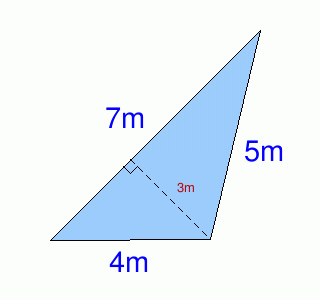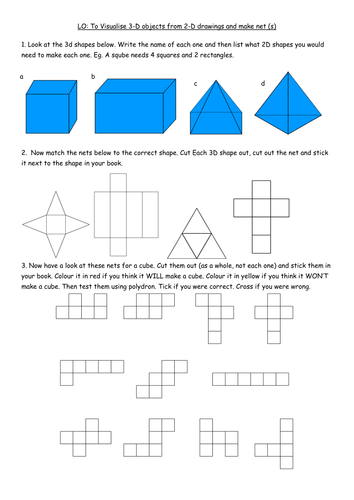What is the definition of a quadrilateral?
Quadrilateral - any shape that has four sides and four angles
What do decompose and recompose mean?
Decompose - take apart
Recompose - put together
What is the definition of area?
Area - The number of square units that cover the region of a 2 dimensional shape without gaps or overlaps
What is the definition of volume?
Volume - The amount of space that makes up the inside of a 3 dimensional shape.
What is the definition of surface area?
Surface Area - the total area of all the faces of a 3 dimensional object
What is the name of this quadrilateral?
Parallelogram
What is the definition of a net?
Net - A 2D pattern that you can cut and fold to make a model of a 3D shape
Answer the questions and label your answers correctly.
a.) A square has a side length 8 cm. What is its area?
b.) A square has an area of 16 cm2. What is its side length?
a) 64cm2
b) 4cm
What is the formula for finding volume?
V = L x W x H
Match the polyhedra to the correct net.
a - 4
b - 2
c - 4
d - 3
What is the name for these shapes?

Polyhedron
What are the definitions of parallel and perpendicular?
Parallel - Lines going in the same direction that will never touch
Perpendicular - two lines that intersect at a right angle (or 90 degrees)
Find the are of this quadrilateral. Label your answer correctly.
9 x 4 = 36cm2
A cube has a side length of 5 inches. Select all the values that represent the cube’s volume in cubic inches.
a) 52
b) 53
c) 6⋅52
d) 6⋅5
e) 5⋅5⋅5
b) 53
e) 5⋅5⋅5
For each pair of numbers, circle the number that is greater.
a) 122 or 132
b) 7⋅52 or 53
a) 132
b) 7⋅52
What are the three characteristics that all polyhedra have?
Faces, edges, and vertices
What are the four things you need to know in order to find the base and height of a parallelogram?
Base and Height of Parallelograms -
Any side of a parallelogram can be a base
A base and its corresponding height must be perpendicular to each other
A height can be drawn inside or outside the parallelogram
A base can be extended to meet a height
Find the area of this parallelogram. Label your answer correctly.

2.5 x 1.8 = 4.5m2
Find the volume of this rectangular prism. Label your answer correctly.

4 x 10 x 3 = 120in3
Find the surface area of the rectangular prism. Label your answer correctly.
17 x 4 x 2 = 136
17 x 10 x 2 = 340
10 x 4 x 2 = 80
surface area = 556cm2
What are the two defining characteristics of a prism?
What are the three defining characteristics of a pyramid?
Prism - has two parallel, identical faces called bases and a set of rectangles connecting them
Pyramid - has one face called the base that can be any polygon and a set of triangles connecting them. All of the triangles meet at a single vertex.
What are the four things you need to know in order to find the base and height of a triangle?
Base and Height of Triangles:
Any side of a triangle can be a base
A base and its corresponding height must be perpendicular to each other
A height can be drawn inside or outside the triangle
A height must measure from the base to the top of the triangle
Find the area of this triangle. Label your answer correctly.

7 x 3 = 21/2 = 10.5m2
Find the volume of this rectangular prism. Label your answer correctly.

4 x 12 x 5 = 240m3
Find the surface area of this triangular prism. Label your answer correctly.
3 x 4 = 12
3 x 3 = 9
5 x 3 = 15
4 x 3 = 12/2 = 6 x 2 = 12
surface area = 48cm2



